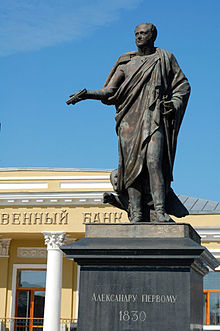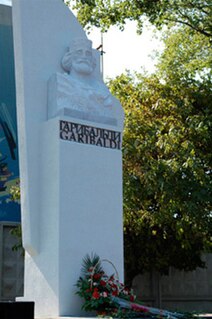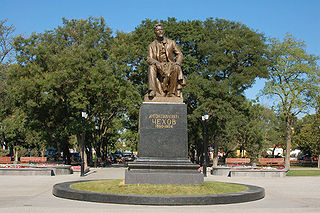Coordinates: 47°13′16″N38°54′32″E / 47.221°N 38.909°E

A geographic coordinate system is a coordinate system that enables every location on Earth to be specified by a set of numbers, letters or symbols. The coordinates are often chosen such that one of the numbers represents a vertical position and two or three of the numbers represent a horizontal position; alternatively, a geographic position may be expressed in a combined three-dimensional Cartesian vector. A common choice of coordinates is latitude, longitude and elevation. To specify a location on a plane requires a map projection.
| Памятник Александру I | |
Monument to Alexander I. Photo taken in 2007. | |
| Location | Bank square, Taganrog |
|---|---|
| Designer | Ivan Martos |
| Opening date | October 23 (11), 1831 new monument open on September 12, 1998 |
| Dedicated to | Alexander I of Russia |
The monument to Alexander I of Russia was erected on the initiative of the people of Taganrog in memory of the emperor's stay and death in the city.
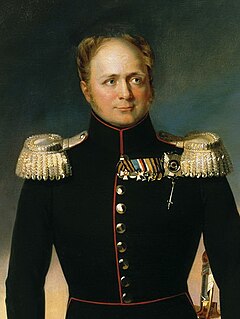
Alexander I reigned as Emperor of Russia between 1801 and 1825. He was the eldest son of Paul I and Sophie Dorothea of Württemberg. Alexander was the first Russian King of "Congress" Poland, reigning from 1815 to 1825, as well as the first Russian Grand Duke of Finland, reigning from 1809 to 1825.
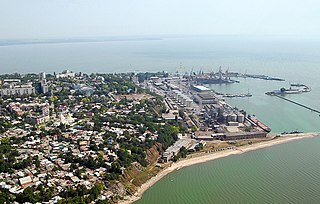
Taganrog is a port city in Rostov Oblast, Russia, on the north shore of the Taganrog Bay in the Sea of Azov, several kilometers west of the mouth of the Don River. As of the 2010 Census, its population was 257,681.
The place to set the monument was chosen by the widow of Alexander I Elizabeth Alexeievna (Louise of Baden) – opposite the Greek monastery. Most of the money to subsidize the construction of the monument was donated by the members of the Imperial house of Romanovs, the rest of the sum was raised by the people of Taganrog.

Princess Louise of Baden was, later known as Elizabeth Alexeievna, the Empress of Russia during her marriage with Emperor Alexander I.
The statue was sculpted by the eminent sculptor, rector of the St. Petersburg Academy of Arts Ivan Martos. The architectural part of the monument was designed by the famous architect Avraam Melnikov.

Ivan Petrovich Martos was a Russian sculptor and art teacher of Ukrainian origin who helped awaken Russian interest in Neoclassical sculpture.
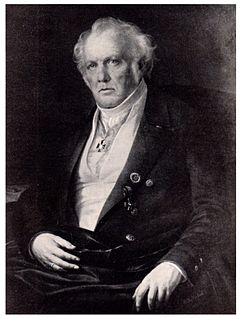
Abram or Avraam Melnikov was a Russian Neoclassical architect associated with the late phase of the Empire style. His teachers at the Imperial Academy of Arts included Andreyan Zakharov. He graduated with a gold medal and went to further his studies in Italy. Melnikov became de facto Dean of the Academy in 1831 but was not officially appointed until 1843.
The bronze figure of the emperor at full height was draped with a simple gown, and a general's uniform was visible under it. The tsar held the sword hilt with his left hand, and carried a scroll which was supposed to be the code of laws. One foot of Alexander I trampled a coiling snake symbolizing the victory over Napoleon. The face of the sculpture was a copy of the emperor's portrait, and the winged angels at his feet pointed out his angelic character. The granite pedestal consisted of three parts, 5 steps led to it. The entire monument weighed about 1600 kg.
On October 23 (11), 1831, celebrations took place on the occasion of unveiling the monument. They included divine services, consecration of the monument, firing a salute, ringing bells at all the churches and evening illumination.
In 1837 cast-iron lumps with heavy chains were added to palisade the monument. In 1888 a square was planted around and fenced with iron forged railings.
In 1920 the monument was destroyed (in 1932 the statue was remelted).
In 1998 in the course of celebrations of the tercentenary of Taganrog the monument was reconstructed according to original plans at the same place. The reconstruction was financed by the Rossiyskiy Kredit Bank.
The original model of the monument is kept in the collection of Russian Museum in Saint Petersburg. [1]
